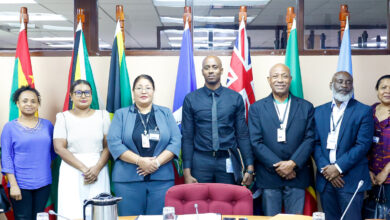It is my pleasure to be present at this important Ministerial Meeting on HIV and Development in Latin America and the Caribbean, when representatives from across our Hemisphere try to grapple with the critical developments, consolidate approaches and shape new initiatives for an adequate response to the disease that has challenged the World for over 20 years. I wish to congratulate UNECLAC, PAHO and the Caribbean Community Secretariat for their joint effort that has resulted in this gathering today. I also join the Chairman in offering a warm welcome to all of you, and in particular our colleagues from Latin America
Permit me to refer to the close alliance between the Caribbean Community and the various groupings in Central and South America. The bond of friendship demonstrated at the Fifth Summit of the Americas in Port-of-Spain is the latest manifestation of Latin America and Caribbean relations.
I am pleased to be involved in this attempt to follow up on The Mexico Declaration 2008 aimed at strengthening the multicultural approaches to HIV prevention, by engaging Ministers and officials of the Education and Health Sectors. Indeed the gathering in Mexico at the Seventeenth International AIDS Conference did establish benchmarks for strengthening prevention efforts through education and comprehensive multi-sectoral approaches to “sexuality” education including curricula development, improved access to services and improved public communication in collaboration with mass media and civil society. What is challenging and positive about the Mexico Declaration are the targets it sets out to be achieved by 2015, such as 75% reduction in schools that do not provide sexuality education and 50% reduction in the number of adolescents and young people who are not covered by health services that appropriately cater to their sexual and reproductive health needs.
I note, too, that two years prior to the Mexico Declaration, in June 2006, the CARICOM Council of Human and Social Development produced The Port-of-Spain Declaration on the Education Sector Response to HIV, placing emphasis on universal access to HIV prevention care and treatment, development of professional and scholarly approaches to effective school health, professionalising the fields of Health and Family Life Education, sexual education and the establishment of a Caribbean Network of HIV Coordinators in the education sector as a CARICOM-led regional resource.
Today, I see this ECOSOC Ministerial Review as a conjuncture of the initiatives of Mexico and Port of Spain that is connected with a series of other commitments, global, regional and national and that seek to impose some coherence in how we move forward with collaborative approach in the fight against HIV in Latin America and the Caribbean
There is no need for me to repeat the glaring statistics of the success and failures to this gathering with respect to prevention of mother-to-child transmission, the prevention of HIV transmission among the general and most vulnerable population and of HIV transmission through transfusion. There is no need for me to stress that with few exceptions in Latin America and the Caribbean, for every five persons on antiretroviral treatment, there are ten new infections, and that among the major threats to destabilizing the gains made in prevention, care and treatment, is the pervasiveness of stigma and discrimination. The statistics for the Caribbean are vividly illustrated in a 2008 publication by UNAIDS aptly called Keeping the Score.
In addition, the background paper for this Meeting: Implementing the Internationally Agreed Goals and Commitments with regard to Public Health: HIV in Latin America and the Caribbean is replete with information of the mixed score card of the achievements of the LAC countries in tackling HIV. It signals the fact that there is no room for complacency. It is clear that the disease is fueled by unprotected sex and that this main mode of transmission constitutes a disproportionate impact on a number of vulnerable groups (women, drug users, prison populations, migrants, indigenous populations and youth). In this regard the most at-risk groups include men who have sex with men and sex workers, both male and female.
What is clear is that the impact to which we refer is not matched by comprehensive prevention, care and treatment programmes that reach these groups effectively. A significant conclusion in the background paper drawn from a series of empirical data is “the persistence of social norms, beliefs and legal policy barriers combine to create highly stigmatized environments where discrimination, homophobia and violence against certain groups thrive, augmenting the impact on those already at high risk for HIV infection”
How do we move forward with an agenda that helps to resolve the dilemmas we face?
Starkly put, after 25 years into the disease there is yet no cure. Notwithstanding the copious declarations and pronouncements, behaviour modification is slow to take root and stigma and discrimination, persist.
As we meet here today it is significant that we are at the half way point between two landmark events: UNGASS (2001) where the global articulation of the issues and advocacy for an accelerated approach to HIV led to the establishment of the Global Fund for HIV TB and Malaria (GFATM) and the Millennium Development Goal (2015).
As we meet here today, our region (LAC) is plagued by the global economic and financial crisis with implications for exacerbating the region’s economic vulnerabilities and compounded by the prospects that investments in the region’s HIV response may be compromised.
Some strategies in the accelerated approach to HIV
There is a wide range of strategies that may be considered in the accelerated approach to HIV, and which applies to both Latin America and the Caribbean. However I would only focus briefly on six illustrations:
i. Maintenance investments in HIV
UNAIDS reports that an estimated US$13.7billion was invested in the AIDS response in 2008. It is also worth noting that the international community has responded to the need for resources to curb the spread of the epidemic with a six-fold increase in funding between 2001-2007. Latin America and the Caribbean has benefited from resources in terms of loans and grants from international development banks and support from bilateral agencies such as the US Presidential Emergency Plan for AIDS Relief (PEPFAR), DFID (UK), CIDA (Canada) and GTZ (Germany), among others. Increase resources from national budgets are a further demonstration. Yet all reports and analysis of the global situation and comparable indications for the LAC region point in the direction of a shortfall such that “ needs” for the HIV response, outstrip available resources by far.
ii. Improving effectiveness of investments
In the context of scarce resources it is important to improve the effectiveness of investments in the HIV response. A strategy that seems to work, is the creation of partnerships, pooling resources, sharing information on best practices , constant evaluation of processes, through monitoring and evaluation techniques Among the examples of effectiveness of investments are those that have been catalyzed by institutional responses that engage networks at national, regional and international levels. Barbados for example, has developed a broad based multi-sectoral involvement of line ministries with corresponding budgets for AIDS related activities , with positive implications for cost saving simultaneously with increasing the impact of HIV relief in that country
The Horizontal Technical Cooperation Group, a network of Government and civil society in Latin America headquartered in Brazil, brings together a cross section of HIV Stakeholders bi-annually in FORO, to identify regional priorities and elaborate relevant and common policies
The Pan Caribbean Partnership on HIV/AIDS (PANCAP) brings together 29 Governments, NGOs and other key partners across the sectors, and regional and international agencies to establish and implement regional priorities with national impact. In achieving its objectives, the Caribbean Regional Strategic Framework is pivotal.
iii. Human Rights and social justice programmes that place emphasis on universal access to prevention care and treatment and on reduction of stigma and discrimination
Universal access to HIV prevention, treatment care and support by 2010 is regarded as the stimulus package that governments agreed to at the United Nations General Assembly in 2006. This is the kernel of goal 6 of the MDGs: halting and reversing the spread of HIV by 2015. However a sustainable approach to achieving this goal is to incorporate in national and regional HIV plans, activities that address multi-sectoral strategies of the epidemic including gender equity, human and social justice programmes that seek to revamp out-dated legislative instruments, adequate nutrition as a basis of successful adherence to treatment of PLWA and alleviation of poverty. In so doing the HIV response also address the broader drivers of development.
iv. Strengthening public health systems
The strengthening of public health systems is important for increasing the opportunities for treatment of PLWA, for community care support services, increasing equity in treatment and coverage and reducing treatment costs. The background paper, prepared for this meeting, makes a case for integrating prevention, care, treatment and support into the public health system. There is some evidence from the experience of Barbados, Brazil and Mexico that this contributes toward the reduction of stigma and discrimination and at the same time increases the numbers of persons that “get tested” for HIV.
In the case of treatment costs, the negotiations for cheaper pharmaceuticals are an important complementary policy. It involves the exploiting the TRIPS flexibilities as demonstrated by Brazil. But perhaps one of the most rewarding and exhilarating experiences from CARICOM was the success achieved by the collective group of Ministers of Health from the Caribbean Community negotiating with six pharmaceutical companies and securing a reduction of up to 90-percent for a range of ARVs, which culminated in the signature of an agreement at the Thirteenth International AIDS Conference in Barcelona in July 2002.
v. Recommitting to the “three (3) ones” principle
I believe that the PanCaribbean Partnership against HIV is an embodiment of this principle which accounts for its success so far. But the sustainability of this principle is highly dependent on the pursuit of a harmonization strategy, in which developing partners’ support for the Caribbean Regional Strategic Framework places emphasis on reducing the duplication in onerous reporting requirements and in which multilateral agencies adopt a more enlightened policy of support for small middle income countries. It is necessary that countries of the LAC region hold firm in their advocacy for the international agencies to change the conditionalities that rob countries like the Bahamas, Barbados and even St. Kitts from access to concessional funding.
vi. Support for People Living with HIV
Finally, the heart of our concern rests with people living with HIV and those affected by HIV. An interesting finding in the background document provided for this meeting is that an increasing number of Persons Living with HIV and AIDS (PLWA) are aware of their status and are surviving because of antiretroviral treatment. This fact provides an enormous prevention opportunity and proper counseling at testing centres and health facilities. But what it also means is that programmes and policies must be put in place to ensure the availability of legal protection and social support and support networks and self help groups. In the final analysis it is important to support initiatives to encourage greater involvement of PLWA.
CONCLUSION
I have tried to sketch the scenarios that appear to be among the major concerns for this Forum, and to identify some of the strategies that ought to form part of a programme and design toward an accelerated approach to HIV. I am sure that in the special panels that follow you will embark on a more systematic set of discussions and arrive at important decisions. What is clear is that both the Health and Education sectors have a critical role to play in this accelerated approach.
Hopefully this meeting will form the basis of a longer term and sustainable partnership, providing a paradigm shift that contributes to radical behaviour change, purposive reduction in stigma and discrimination, achieving universal access to prevention, treatment care and support and involving people living with HIV in fashioning a sustainable and successful response to HIV.
In this regard I hope that these remarks contribute in some way to the deliberations at this important Annual Ministerial Review.





